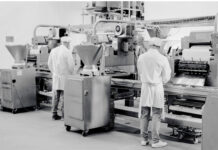
Automation of manual set-up and measurement processes can make the company more competitive. In the food industry, automation meets the needs for traceability which is requested not just by regulators but also by customers and consumers.
These days automation technology is not applied exclusively to industrial production systems. Artisanal production is automated as well, albeit limited to only a few technologies so as not to lose that which sets an artisan product apart – product uniqueness, a level of quality tightly linked to the artisan’s ability, and non-standardized production. Nonetheless, consumers still judge industrially produced foods by qualitative standards much similar to artisanal ones. Industrial foods are expected, like artisan’s products, to preserve the highest possible number of characteristics of product uniqueness. Thus, a need has emerged in the market for automated machines that are able to reproduce the “defects” of manual work. Automation has contributed to the development of industrial production systems that are capable of more unique, distinct and sequential production cycles, thanks to the use of machines that are more specialized.
From rigid to flexible automation
In the 60s, mass production was achieved by automated machines that were able to execute repetitive operations, but were not easy to modify. Automation was rigid. In the following years, consumers began to ask for a more highly segmented product offering. It became necessary to reduce production volumes, increase the number of product variations and lower production times to meet the needs of an evolving market. The trend was towards production models and as a consequence, flexible automation. Automation was applied not only to the production machines, which became re-programmable and multi-functional, but also to information technologies for the organization and management of production. As an example, there was Just In Time, which eliminated stocking raw materials and end products and reduced production downtimes. Quality control was applied to the entire production cycle. It was the era of computerized numeric control (CNC), programmable logic controllers (PLC), material movement systems (MMS), robots, all integrated through an information network. The design phase was not an exception. It became impossible to work without a calculator and CAD (Computer Aided Design), CAM (Computer Aided Manufacturing), CAE (Computer Aided Engineering) were all used to link design to production. Furthermore, design and production were increasingly integrated with company management systems. The management of all company activities, production and services, was computerized. To deal with the increased level of complexity in production lines, companies adopted standardized and repeatable processes, that could be rapidly controlled, even remotely. Process automation began to appear in the food industry, which solved the problem of traceability with a system that could monitor the entire production process, providing real-time information on the product, its production and ingredients,
Advantages of process automation
Process automation offers many known advantages. First of all, there is increased efficiency and safety regarding systems, facilities and products. Without automation, workers would have to personally and physically monitor the different machine parameters that are utilized. This type of monitoring would be periodic, not continuous, and would require programmed maintenance at regular intervals and not based on the real requirements of the machine. With process automation, sensors are placed all along the system to record the fundamental parameter values in real time and on a continuous basis for successful production, like temperature, pressure, and speed of the machine, as well as temperature, pressure, pH, and density of food products. The parameters are automatically regulated to optimize the production. Furthermore, where necessary, the system operators can decide to manually de-activate the process automation system. In addition to better and more efficient control of production parameters and machine performance, process automation also brings with it significant energy savings. Modern software, in fact, utilizes collected data to increase the system performance in order to minimize energy consumption. Automatically controlled machines guarantee constant quality, with minimized energy waste, functioning at the optimum level required in the specific time period. Continuous control reduces the amount of defective product produced and allows for regular system maintenance, limiting the number of production stops and re-starts of the machines for inspections. There are even examples of boilers with systems that control the quality of the flame and the combustion residuals.

The integration of automation and production process management
The integration of automation and production process management is essential so that information can be collected to quickly manage and adequately deal with the different problems that can arise in production. For this reason, information solutions to integrate and automate the quality control procedures for processes and products are needed (for example, systems that collect and store data and analyse problems encountered on the production line and in the end product). The data collected is stored in a company database and then is made available to those responsible for planning and monitoring corrective actions. The possibility of conducting an analysis on every single production step has the advantage of being able to more efficiently control the production process and to more effectively introduce corrections for the improvement of isolated steps in the process, rather than at the end of the entire process. One of the objectives of storing data in a central database is to make it available to all production lines in plants across the nation or abroad. In this way, it is possible to analyse the data collected in order to assess the product as well as monitor and correlate analogous data from other production sites. These systems guarantee an information flow on the process and products that is constantly updated and immediately available to the different players involved in the production process. The system is composed of programs and control devices for the industrial machines, operator panels, computers and devices for controlling and managing the machines, pcs, and software for process control, industrial networks, interface solutions that integrate the factory, warehouse, production and administration, data collection systems, and processing of data and production times. Data is exported to ERP and management software platforms. There is also hardware and software for identifying and marking for traceability along the production chain. With the use of technological platforms it is possible to link systems from different suppliers both through the integration in the ERP software or by directly connecting production processes. The platform, in fact, communicates with all the PLCs so that recipe data can be sent, along with a historic view of the most important process values and states, for example all the variables involved in different recipes used by a company (weights, times and raw materials). It is possible to view the production status at any moment and to graphically see the trends on important parameters. This allows for proactive management rather than waiting for problems to show up at the end. It is also possible to consult inventory levels in real time. With a higher level of control and total access to information, along with the ability to manage production processes and the entire production chain, across multiple production sites, companies now have a major competitive advantage.




